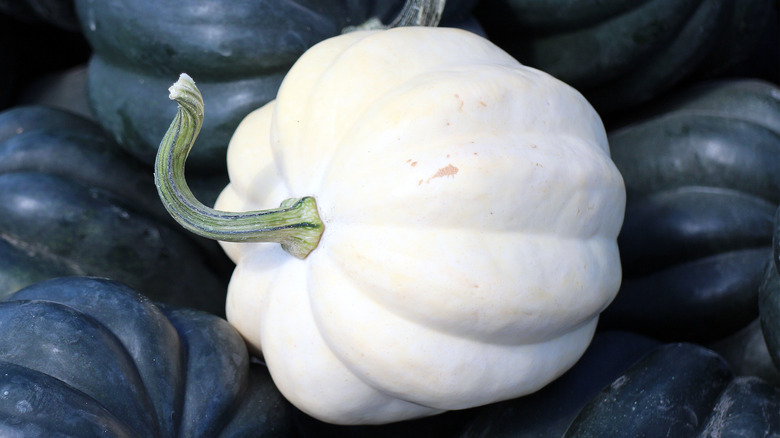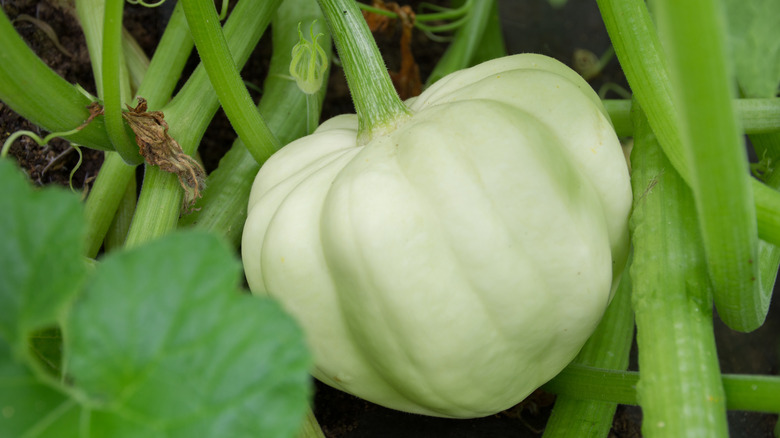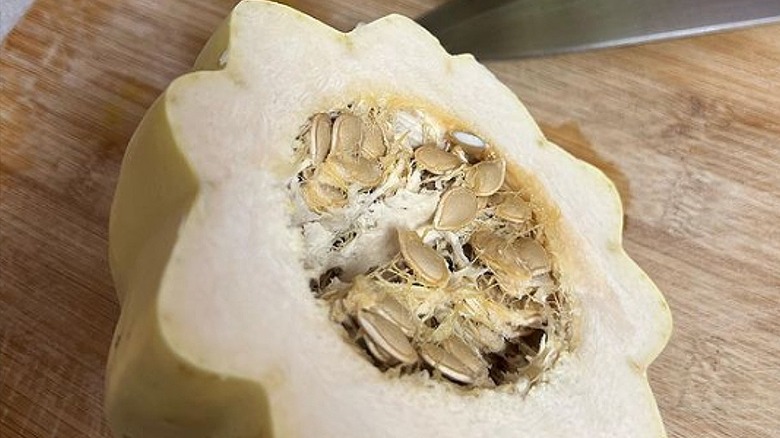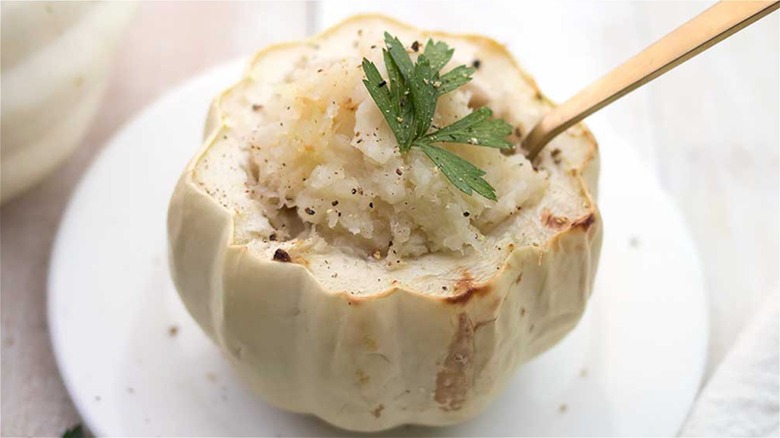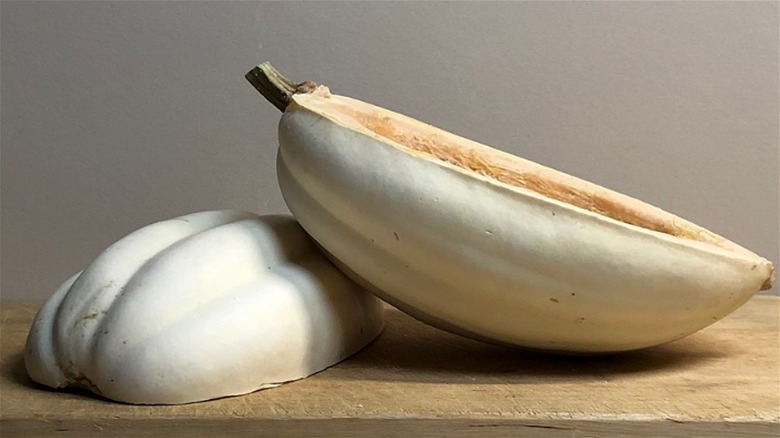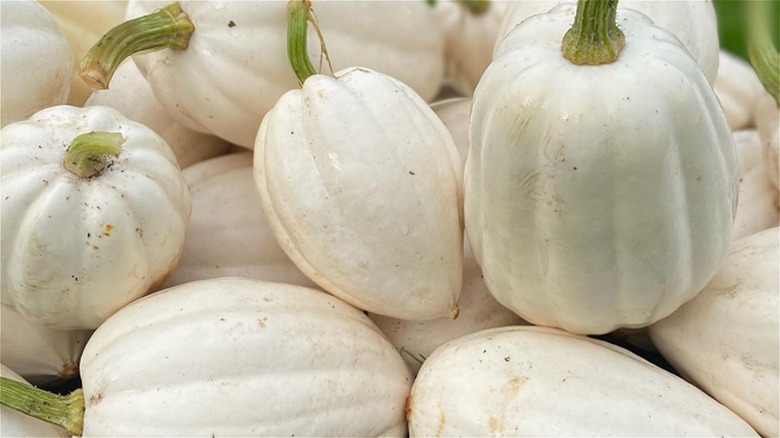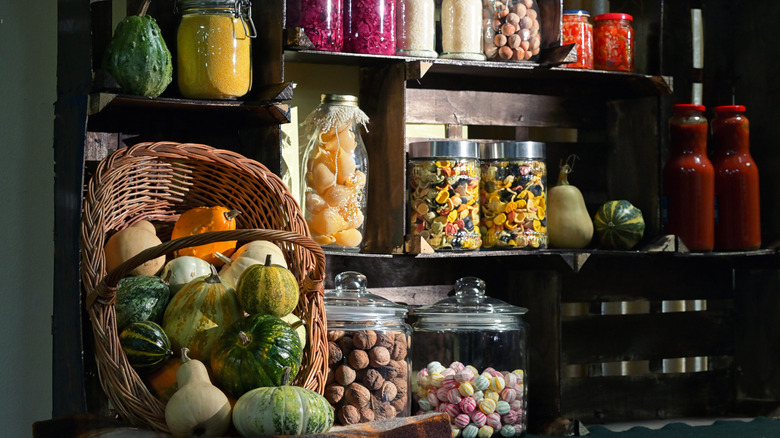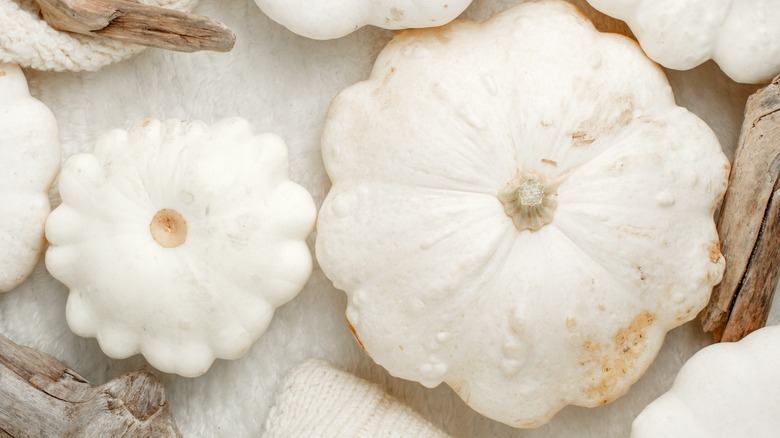What Is Mashed Potato Squash And How Do You Cook With It?
Over 100 hundred known species of winter squash exist, but it's fairly unlikely that you'll find yourself faced with every single one at your local farm's market. There is, however, one that might catch your attention. Resembling a large white acorn, the mashed potato squash is an intriguing prospect for both the eyes and the stomach.
Also known as white acorn squash or botanically as Cucurbita pepo, the mashed potato squash gained its latter name from its appearance after being cooked. With off-white ivory skin and pale yellow flesh, the mashed potato squash is delicious, starchy, and soft.
The squash is best sliced in half and baked or roasted in the oven to achieve its prime consistency. This allows the firm flesh to break down into a soft, creamy texture that, once fluffed, looks and tastes surprisingly similar to mashed potatoes. You may have previously mistook this squash for an ornamental white pumpkin, but there's plenty more to discover beneath that creamy white skin.
Mashed potato squash characteristics
Along with gourds and pumpkins, squash is believed to have been domesticated as far back as 10,000 years ago. However, the mashed potato squash variety was developed in the 1980s by Glenn Drowns. Like other squash, mashed potato squash is considered a fruit, as it contains seeds and has fruit that grows from the plant's flowers (instead of from the root, stem, or leaves like vegetables).
Its shape closely resembles the green acorn squash variety, which is believed to have been cultivated by the Arikara tribe of the Great Plains region (located east of the Rocky Mountains). So, while its color may be a recent development, the mashed potato squash's heritage spans centuries. It is now a popular squash to grow in gardens throughout the U.S. due to its easy-to-grow reputation.
Mashed potato squash is part of the Cucurbitaceae family, along with 800 other species including cucumber, melon, and pumpkin. It's typically considered a small to medium-sized squash and can measure up to 4 inches in height and 6 inches in diameter. The white acorn squash's weight can also fluctuate, with some smaller fruits coming in at 1 pound and others weighing up to 2 ¾ pounds.
Mashed potato squash taste profile
Even though the mashed potato squash may not resemble a potato in appearance, its taste and texture closely mirror it. However, they're distinguished by their flavors.
The mashed potato squash is prized for its mild taste and subtle sweet aromas. There are also some black peppery undertones and nutty hazelnut notes. This fruit is miraculous because it feels like a hybrid between white potato and sweet potato. Yet there's also a delicacy to the mashed potato squash that gives it a lighter taste and consistency compared to potatoes.
While acorn squash can be eaten raw, they reach their full flavor potential once cooked. The transformation in the texture of the mashed potato squash is also enticing, as the flesh turns from starchy to fluffy. Once mashed, it's almost as if butter has already been added, as the mashed potato squash takes on a creamy and silky finish.
How to cook with mashed potato squash
The wondrous mashed potato squash can be roasted, baked, broiled, or grilled to achieve the desired texture of mashed potatoes. The squash is filled with chunky seeds similar to a pumpkin, and when preparing the squash, it's best to remove these. You do not need to discard them, as you can easily roast the seeds like you would roast pumpkin seeds.
Once cooked, the mashed potato squash can easily add more flavor to sweet or savory dishes. For a mashed potato vibe, you can always mash the squash's flesh and add the usual suspects (milk, butter, and seasoning) to mimic the creamy side. The squash can also be topped with flavors that complement the fruit's potato-ness, such as sausage, cheese, and mushrooms.
For those with a sweet tooth, the white acorn squash can be baked in honey, maple syrup, cinnamon, or citrus. These flavors blend wonderfully with the sugary tones of the squash to create a comforting treat. A step further would be to add it to baking — simply puree the cooked squash and substitute it for pumpkin. Especially with the nutty flavors in the squash, it'll wonderfully capture that fall-spiced feel. Mashed potato pie, anyone?
Mashed potato squash nutrition
Mashed potato squash, like other acorn squash, is bursting with nutrition. With high levels of magnesium, vitamin C, and vitamin A, they are also brimming with antioxidants. One of particular note is carotenoids, which provide a ton of complementary amino acids and may even have the ability to protect against type 2 diabetes and lung cancer.
These fantastic squashes are also rich in potassium, with half a cup of the fruit containing up to 1783mg — for context, the general recommended daily allowance is 2,600mg for women and 3,400mg for men (aged 19-50). Mashed potato squash is also a dietary fiber powerhouse, which is ideal if you're seeking fresh produce to keep your gut healthy.
One of the popular reasons to choose this squash is its position as a lower-carb option compared to potatoes: One cup of mashed potato squash has 22g of carbs compared to the 35g found inside a cup of ordinary mashed potato. However, if you are on a low-carb diet, such as keto or Atkins, you may have already recognized that acorn squash varieties are not considered appropriate for a low-carb diet.
Where to buy mashed potato squash
Mashed potato squash usually grows best in a warm climate and can only survive a light frost. Because of this, you are most likely to find mashed potato squash at the farmer's market or local greengrocer in the fresh produce section between the summer and fall seasons. If conditions are appropriate, they may well grow outside of these seasons, and since this squash is starting to gain recognition, it may begin appearing in bigger retail chains.
If you're met with a table of mashed potato squash, you can tell if the fruit is ripe by pressing a thumbnail against the skin; if it doesn't leave a mark, that means it's ripe. Also, you'll want to ensure the stem is dry and brown, as this usually indicates the fruit is ready to be harvested.
If you're lucky enough to live in Missouri, then you'll be pleased to hear that City Greens Market offers organically grown mashed potato squash in stores and through their online shop.
How to Store Acorn White Winter Squash
Like other winter squash, the white acorn squash is renowned for its storage capabilities. Before storage, it's advisable to scrub the fruit with hot water, which can potentially extend its shelf life by removing mold spores. However, store-bought squash is typically pre-washed and waxed before being sold, which already provides a level of protection against mold.
Acorn squash is best stored in a cool, dark place, around 50 degrees Fahrenheit, which could be maintained in a pantry, shelf, or cabinet. Since acorn squash is susceptible to frost damage, storing them in a refrigerator below 50 degrees Fahrenheit can damage their taste and texture. Prime storage conditions include low humidity and good airflow. While storing, make sure you check on the squash often to ensure it hasn't developed any soft spots. By rotating the fruit throughout storage, you can also prevent the fruit from bruising. In these conditions, a mashed potato squash can last between one to two months.
If cooked, mashed potato squash can be stored in the refrigerator for three to four days; if frozen, it's best used within three to four months. After any longer than that the taste, color, and texture will deteriorate.
Mashed potato squash, patty pan, and pumpkins
While the acorn shape and white color of the mashed potato squash may feel wholly unique, some other varieties of squash and pumpkin can also mimic this. The first is a white patty pan squash. A patty pan, or scallop squash, is a summer squash that embodies some characteristics of zucchini. While on the vine, there is a time when the white patty pan and mashed potato squash are indistinguishable; however, once ripe, the patty pan grows out widthways, resembling a scallop or retro flying saucer (UFO).
White pumpkins can also be fairly similar in appearance to the mashed potato squash. However, their more rounded shape is a good indicator of their difference. The taste, as well, is another defining feature, as pumpkins tend to have a much stronger flavor. White pumpkins have a denser texture once cooked than white acorn squash, which has a nice fluffy consistency. Of course, fruits and vegetables do not always grow as we expect, and if you're unsure which variety is which, ask the seller before purchasing.
Mashed potato squash is a distinctive and delightful squash variety. And especially if you appreciate mashed potato and squash, you'll be pleasantly surprised by this fruit's unique shape and taste.
